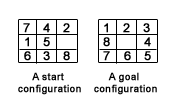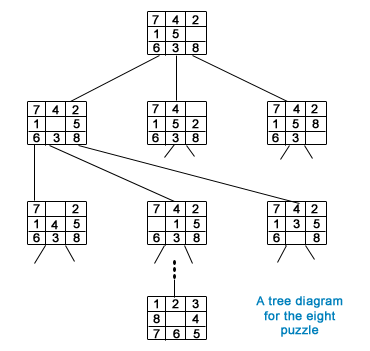|
Search : Introduction
Q. Describe briefly the following AI technique:
Search (June 99) |
|
Ans. Search is one of the operational tasks that characterize
AI programs best. Almost every AI program depends on a search
procedure to perform its prescribed functions. Problems are
typically defined in terms of states, and solutions correspond
to goal states. Solving a problem amounts to searching through
the different states until one or more of the goal states
are found. Search is ubiquitous to AI. For every problem there
are numerous alternatives to consider:
- When attempting to understand a natural language, a program
must search to find matching words that are known, sentence
construction, and matching contexts.
- In vision perception, program searches must be performed
to find model patterns that match input scenes.
- In theorem proving, clauses must be found by searching
axioms and assertions which resolve together to give the
empty clause. This requires a search of literals which unify
and then a search to find resolvable clauses
|
Search Problems
Q. Explain the following problems:
- The Eight Puzzle Problem (June 00, Jan. 01, Dec. 01)
- Travelling Salesman Problem (Jan. 01, June 02)
| 1. The Eight Puzzle Problem |
|
This problem consists of a 3 by 3 square frame which holds
eight movable squares tiles which are numbered from 1 to 8.
One square is empty, permitting tiles to be shifted. The objective
of the puzzle is to find a sequence of tile movements that
leads from a starting configuration to a goal configuration
as shown in the following figure:

The states of the eight puzzle are different permutations
of the tiles within the frame. The operations are permissible
moves: up, down, left, and right. An optimal solution maps
the initial configuration to the goal configuration with the
smallest number of moves. The following figure depicts the
search space for the problem.

In the above figure, the nodes are depicted as puzzle configurations.
The root node represents a randomly chosen starting configuration,
and its successor nodes correspond to the three single tile
movements that are possible from the root. A path is a sequence
of nodes starting from the root and progressing to the goal
node.
|
| 2. Travelling Salesman Problem |
|
The traveling salesman problem involves n cities with
paths connecting the cities. A tour is any path which begins
with some starting city, visits each of the other cities exactly
once, and returns to the starting city.
The objective of a traveling salesman problem is to find
a minimal distance tour. If there are n cities, there are
(n - 1)! possible ways for tour. For example a minimal solution
with only 10 cities is tractable (3,628,000 tours). One with
or more cities is not, since a worst-case search requires
on the order of 20! (about 23 x 1017) tours.
Without knowing in advance the length of a minimum tour,
it would be necessary to traverse each of the distinct paths
shown in the following figure and compare their length. This
requires some O(n!) traverses through the graph, an
exponential number.

|
|
|